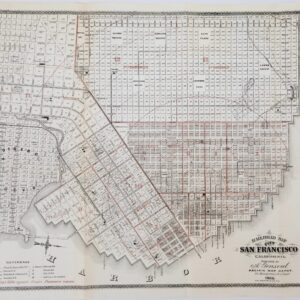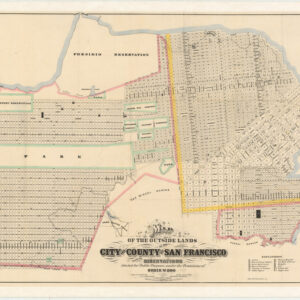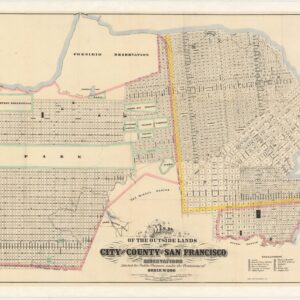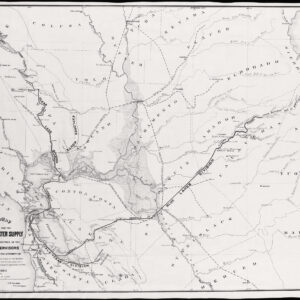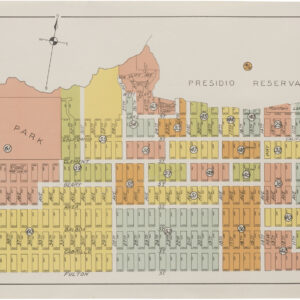A stunning collection of photographs showing the immediate aftermath of the 1906 San Francisco earthquake and fire.
[DRAMATIC ALBUM OF 1906 S.F. EARTHQUAKE]
Out of stock
Description
This scarce hand-made album of silver-gelatin prints is the most comprehensive and visually explicit documentation of the 1906 San Francisco earthquake we have ever encountered. It is one of two known albums composed by George S. McComb, but whether McComb was the photographer or acquired the images from other photographers in San Francisco is unclear.
The album consists of 68 well-preserved silver photographs, most of which measure 27.7 by 34.5 cm (11 by 13.5 in). The prints are mounted in a black limp-cloth folio and are captioned in white ink by an elegant hand. It is clear by their arrangement that George McComb had a keen sense of drama and visual narrative.
The large number of of photographs in this album and the diversity of their subject matter make this album one of the best visual documentations of the earthquake and its aftermath. It is crafted to draw viewers in and engage them emotionally. Among the most potent elements of this McComb album is the conscious decision to repeatedly provide before and after shots of a given perspective. In many cases, the photos are taken from the same vantage point, underscoring the scope and drama of the destruction.
Another essential element in these comparative suites is the varying subject matter, which ranges from specific buildings like City Hall (photo nos. 1 & 2), the Hall of Justice (nos. 63 & 64), or the Call Building (nos. 19 & 20), to sweeping views of the city (e.g., nos. 42 & 43 providing a panoramic view from Twin Peaks). Even for viewers unfamiliar with the city, these juxtapositions capture the otherwise incomprehensible scale of destruction. The album furthermore contains captures of the disaster as it was occurring and many images of the immediate and tangible aftermath of that same destruction.
Additionally, McComb had the contextual understanding and empathy to portray some of the social consequences of this devastation. The album is filled with images that reveal the hardships that the inhabitants of San Francisco had to go through that spring. Congregating in the open spaces of Jefferson (no. 30) and Union Square (no.14); operating soup kitchens (no. 41); standing in bread, fuel, and waterlines (nos. 35-38); or establishing makeshift shelters in the streets and the hills outside San Francisco (nos. 31-33). The growth of formal refugee camps in the Potrero District (no. 39) and North Beach (no. 40) is also documented. At least one photo captures looters at work in the ruins of Sutter Street (no.44).
McComb had a knack for selecting images that could document the event and its effects while soliciting an emotional response. While the social consequences of the catastrophe spoke to most people, the images of burning buildings, warped streets, and entire districts leveled made an impact on the American public. Within the pages of this extraordinary album, we find many such photos, including some of the iconic neighborhoods and buildings burning so intensely that flames and smoke block out the sun (e.g., looking down Mission St. [nos. 15-17, 22-23] or Geary St [no. 49], on Union Square [no. 66], or around the Call Building [18 & 20]).
Photo number 29 offers a view of the burning city from the Bay, emphasizing the violence and sheer extent of the conflagration. Other images reveal a scorched landscape where entire neighborhoods had once been. As if to underline the effects of the cataclysm, the latter half of the album is full of images after the flames had died out. Famous San Francisco landmarks, such as the Majestic (no. 54-55), Columbia (no. 52), and California Theaters (no. 53), or iconic hotels like St Francis (nos. 56-57), Palace (nos. 45-46), or Fairmont (no. 62), stand as skeletal remains in a field ruins. In many cases, McComb also includes images of the interior devastation.
In sum, this album constitutes one of the rarest, finest, and most comprehensive documentations of the catastrophe that struck San Francisco in 1906. It encapsulates not only the overwhelming loss of property and beauty but also the chaos, fear, and hardship endured by her citizens, thus testifying to the impressive resilience of San Franciscans.
Census
We find one other example of a photographic album compiled by George S. McComb. Neatline’s example is untitled per se, having only the words “Geo. S. McComb. S.F. Cal.” written in white ink across the cover. The other example of McComb’s folio album is inscribed “Photographic Souvenirs of the San Francisco Calamity” on the cover. This contained 71 silver photographs and was sold with Bonhams in 2012 (for $8,750). While it is hard to know whether or not McComb, in addition to being the compiler also, was the photographer, at least one photograph in the Bonhams album bears a copyright stamp of “A. Blumberg, Alameda, CA” on the verso.
The OCLC has no examples listed, just as searches on Calisphere.org and rarebookhub.com yield no other results. It is consequently an album of both considerable historical import and utmost rarity.
CLICK HERE TO DOWNLOAD PART ONE OF THE ALBUM
Cartographer(s):
Little is known about the life of George S. McComb. From a notice on page 15 of The San Francisco Examiner for December 1st, 1889, we know that he married one Josephine E. Silva in late November of that year. We glean from the same notice that the groom’s father was General John McComb, who emigrated to San Francisco in 1849, where he worked as a printer for many years, including as manager of the State Printing Office. In 1861, McComb Sr. joined the California National Guard and was ultimately appointed Brigadier General in 1875. When the San Francisco Riot broke out two years later, McComb Sr. was asked to mobilize the State Militia to suppress the rioting.
From a 1918 court case in which George S. McComb testified as a witness, we learn that he worked as a deputy clerk at the Superior Court of the City and County of San Francisco between 1891 and 1892, clerking for Judge Troutt. Other than this, his personal history is obscure.
Condition Description
68 silver photographs. 34.5 x 28 cm (13.5 x11 in). Photos mounted in limp black cloth folio.
Binding somewhat worn; photos slightly oxidized, but still with excellent quality and each securely mounted; very good or better.
References
